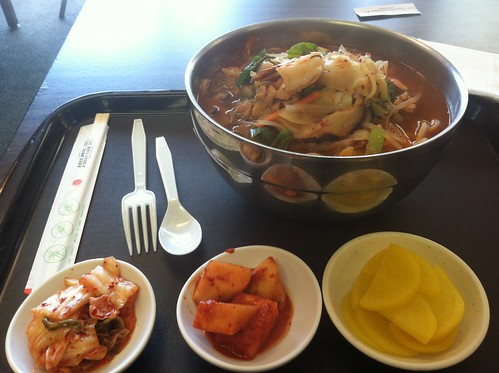Global Food, Locally” is a series designed to introduce you to the International and Area Studies Library’s new graduate assistants as well local dining options for food from around the world. In our first installment, Quetzalli Barrientos ventures out to try Korean food at A-Ri-Rang.
As a new graduate student at U of I’s Library and Information science program, I am new to the school, the campus, but most importantly, I am unfamiliar with the local restaurants. Anyone who’s moved to another place knows that the local food is an important part of settling in a new place. It’s a way to socialize and enjoy new things. My inspiration to try Korean food came from being surrounded by the different area studies materials available at the International and Area Studies Library (IAS).
As I have never had Korean food, I was eager to go to a Korean restaurant. I checked out is A-Ri-Rang, which was recommended to me by another Graduate Assistant at the International and Area Studies Library. It is located on Wright Street, just a couple of minutes from the quad. I walked in on a Wednesday afternoon and, of course, a couple of students, as well as a few families, were there enjoying their food.
As I walked to the counter, I already had a dish in mind “ChamPong” had been recommended to me by a friend. That said, I had no idea what it was and had no idea what to expect. Once I paid, I walked back to a big table, sat down, and looked around the cafeteria-style restaurant. Ten minutes passed as I sat awkwardly: when I ordered at the counter, the man had told me that it would take a “very long time.” Twenty minutes passed and I finally got my order.

Lunch is served! “ChamPong” at A-Ri-Rang.
Now remember, I ordered blindly on the recommendation of a friend. I had no idea what to expect and, to my surprise, I saw a soup. I took the tray back to my seat and stared at it for a couple of seconds. From what I could tell, it contained noodles, some vegetables, broth, shrimp, and several other ingredients. Knowing I would spend another twenty minutes just trying to figure out the chopsticks, I took my fork, wrapped some noodles around it, and tasted the dish. Not bad! I quickly figured out the ingredients to this dish: shrimp, mussels, noodles, carrots, squash, mushrooms, and a few other kinds of seafood.
Those who know me know that I am not a huge fan of seafood. I’ve always found the notion of eating things from the sea a bit odd. That said, I found the meal to be delicious and spicy (very spicy!). For those who are not used to such spicy food, be prepared to take a couple of breaks in between bites and have a tissue ready for that runny nose. A Ri-Rang is a place that I will definitely be going back to try more dishes. Though next time I think I’ll try a dish that is less spicy.
This experience piqued my curiosity about Korean food so I decided to use the library and do a little research to find out more about it. I was able to find a couple of Korean cookbooks in the catalog to familiarize myself with the cuisine. Some books that I found among the collection of the library were “The Kimchi Chronicles” by Marja Vongerichten. If you want to familiarize yourself with Korean food, this book is definitely helpful in getting you started. For those on a health kick, another helpful cookbook that I found is “Korean Cuisine: Healthy Food, Full of flavor” by Yongja Kim.
As I mentioned, I had never tried Korean food until that Wednesday. What else was I missing out on? I searched the IAS website to find out what additional resources are available to me as a graduate student. For someone, like me, who doesn’t know Korean, the IAS website includes a tab for dictionaries. I scrolled though the list and found a Korean multimedia online dictionary. The dictionary is organized into a variety of topics such as fruits, transportation, numbers, and many others. I explored the “food” category and clicked on each image to hear the Korean word for the dish is said aloud. Interested in learning Korean? Access the IAS dictionary page to see the electronic and print dictionaries available. Maybe when I return to A-Ri-Rang, I can ever order my meal in Korean. How cool would that be?
Sources:
Lee, Hyosang, and Aenglan Kim. “Korean Multimedium Dictionary.” Korean Multimedia Dictionary. Indiana University, 2003. Web. 06 Sept. 2013.

